During a recent trip to Batangas, I found myself seeking shelter from an unexpected afternoon downpour in a small, unassuming eatery called a "lomi haus." The warmth from the kitchen and the irresistible aroma of garlic drew me in, but what truly captured my heart was watching Aling Carla, the 67-year-old owner, masterfully prepare her famous lomi. With practiced hands that spoke of decades of experience, she transformed simple ingredients into what locals proudly declare as the best lomi in the province.
"The secret," she confided while stirring the thick, golden broth, "is in how you time each ingredient." She went on to explain how the dish tells the story of Filipino-Chinese cultural fusion, perfected over generations in the bustling streets of Batangas. As rain drummed against the tin roof, she guided me through each step, sharing not just a recipe, but a piece of Batangas heritage that has comforted hungry souls for generations.
This recipe is my tribute to Aling Carla's generosity and the wonderful afternoon where I learned that sometimes the best culinary discoveries happen when you least expect them. While she keeps some secrets close to her heart, this version comes pretty close to that memorable bowl I enjoyed on that rainy Batangas afternoon.
Jump to:
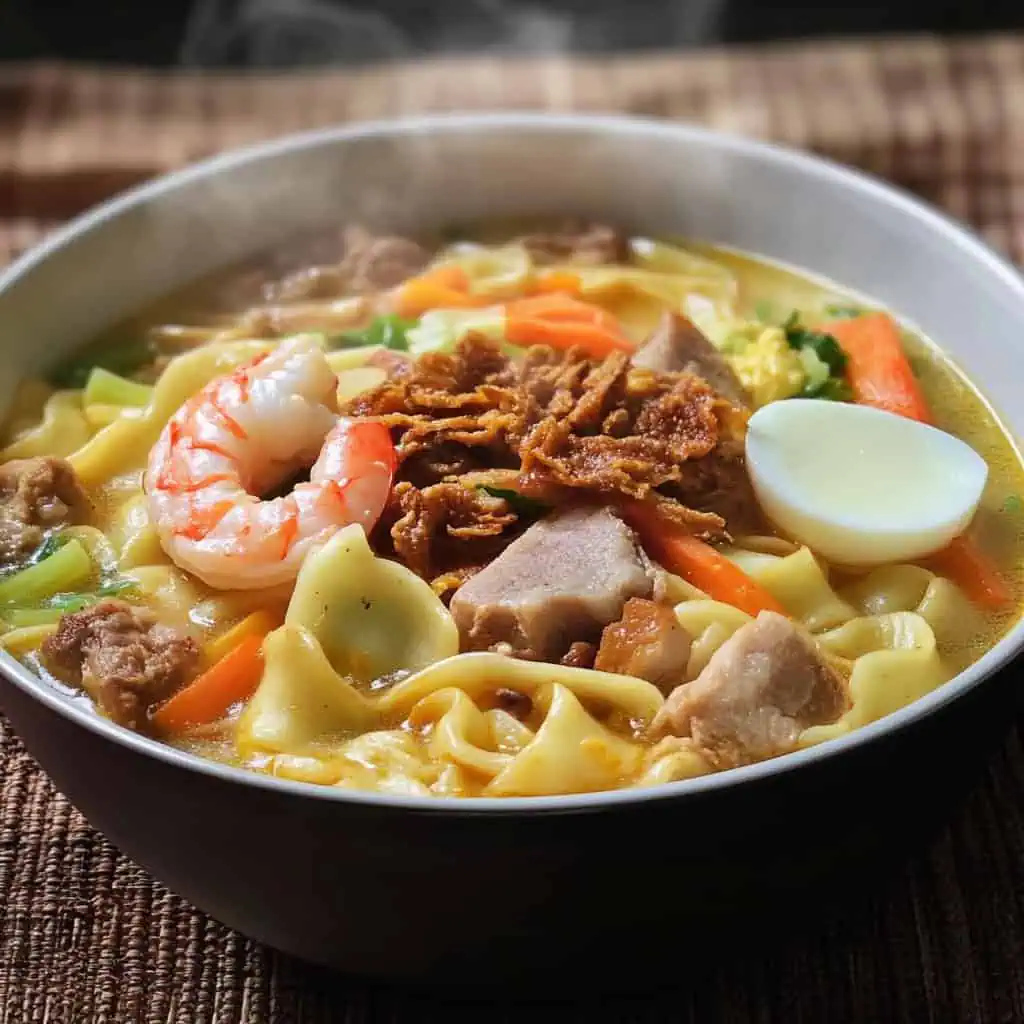
Why You'll Love This Recipe
- Authentic Batangas taste perfected through generations
- Restaurant-quality results from your home kitchen
- Customizable toppings and garnishes
- Budget-friendly yet impressive enough for special occasions
- Perfect balance of textures: chewy noodles, crispy pork, and silky broth
Ingredients
The ingredients in authentic Batangas Lomi are carefully selected to create the perfect balance of flavors and textures. Thick egg noodles form the hearty base, while cornstarch creates that signature silky-thick broth that distinguishes Batangas Lomi from other noodle soups.
The combination of crispy pork belly and tender prawns provides contrasting proteins that complement each other, while fresh vegetables add color, nutrition, and crunch. Fish sauce delivers the essential umami depth that makes this dish so satisfying and comforting.
Every element serves a purpose, creating a harmonious bowl that has stood the test of time in Filipino cuisine.
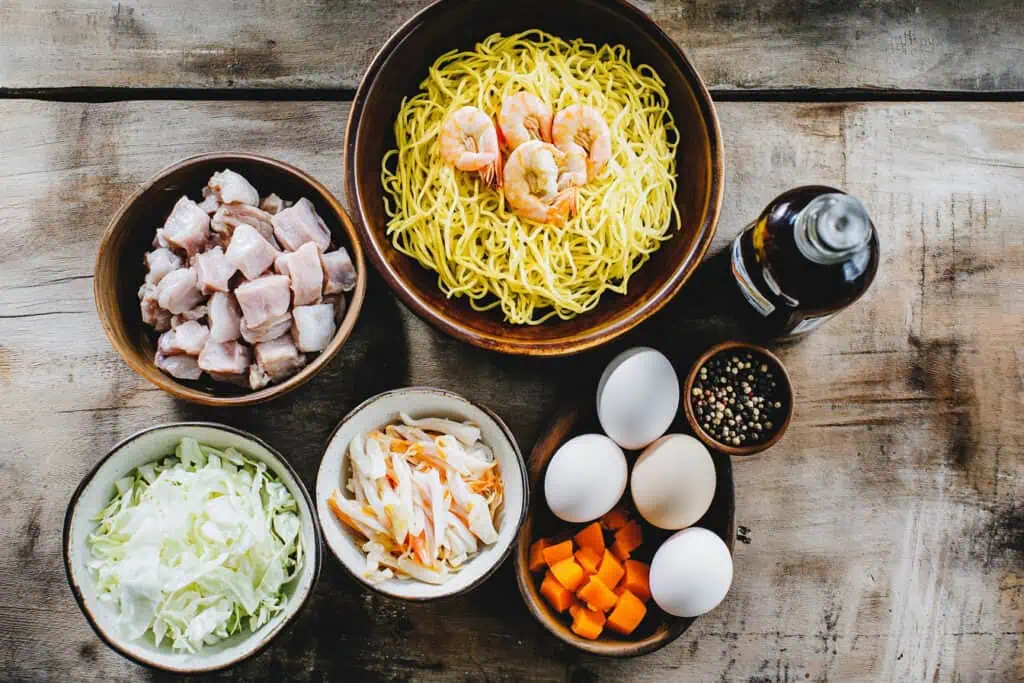
For the Broth Base:
- 500 g thick egg noodles (lomi noodles)
- 6 cups chicken stock
- 2 tablespoons cornstarch
- 3 eggs, beaten
- 6 cloves garlic, minced
- 1 shallot, finely chopped
For the Toppings:
- 1½ cups pork belly, cubed
- 10 pieces squid balls, halved
- 12 medium-sized prawns, cleaned
- ¼ head cabbage, shredded
- 1 large carrot, julienned
For Seasoning:
- Fish sauce (patis) to taste
- Fresh ground black pepper to taste
- Cooking oil
Optional Garnishes:
- Chopped green onions
- Fried garlic
- Calamansi
- Fresh red onions, chopped
- Bird's eye chilies (siling labuyo)
Equipment
- Large stockpot (kaldero): For cooking the broth and assembling the dish. This is essential for achieving the proper volume and allowing ingredients to simmer together properly.
- Wok or deep frying pan (kawali): For crisping the pork belly. The high sides help contain splatter while achieving perfect crispiness.
- Strainer: For draining the noodles properly without losing their texture.
- Sharp knife: For precise ingredient preparation, especially important for julienning carrots and chopping proteins uniformly.
- Wooden spoon: For stirring without scratching your pot and gently incorporating the cornstarch slurry.
- Measuring cups and spoons: For accurate measurements, particularly important for the cornstarch ratio.
- Small mixing bowl: For preparing the cornstarch slurry without lumps.
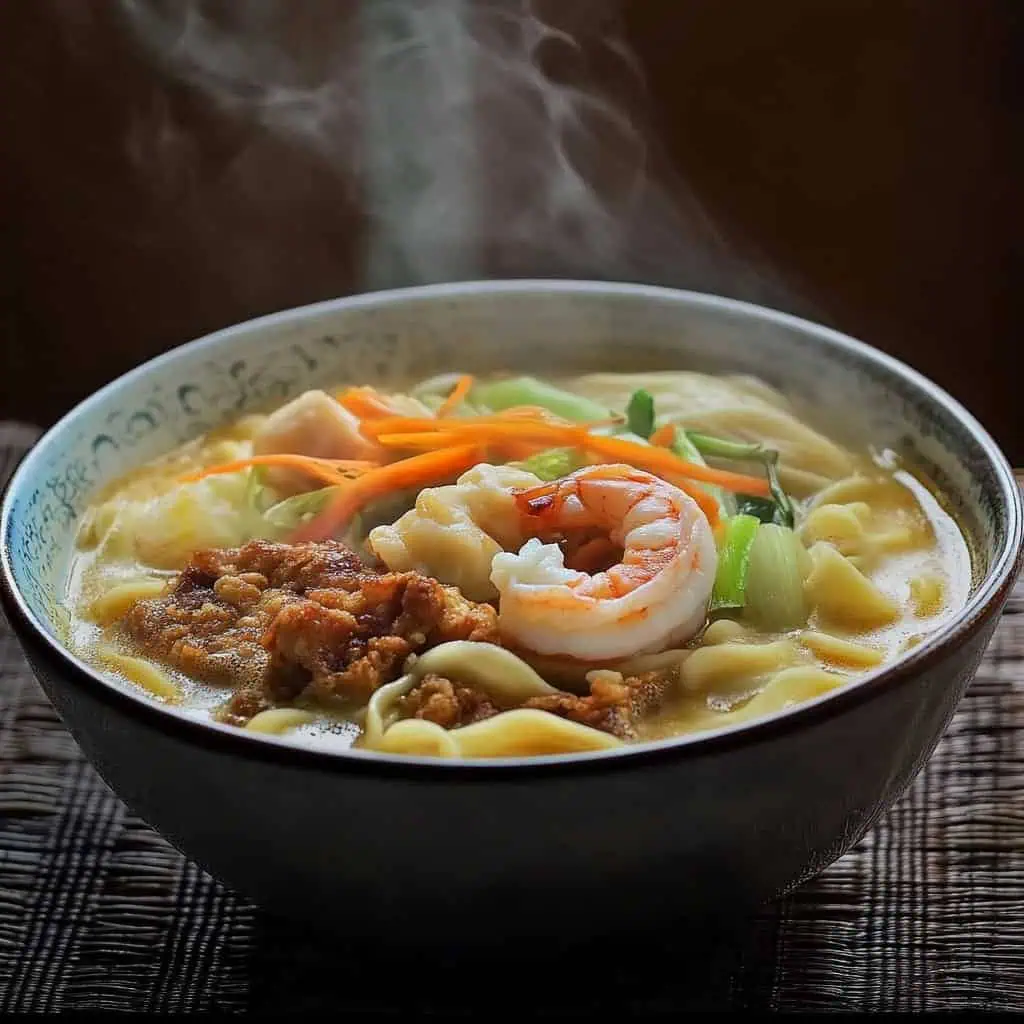
How To Make
- Prep work: Set out all your chopped vegetables, meats, and seasonings within easy reach of your stove.
- Cook the noodles: Cook the lomi noodles in boiling water until they're chewy but not mushy, about 5-7 minutes. Drain them and rinse with cold water to stop the cooking process. Set aside.
- Crisp the pork: Heat oil in a deep pot over medium-high heat. Add your pork belly cubes and fry until they turn golden brown and crispy, about 5-7 minutes. Remove the pork and set aside, leaving the oil in the pot.
- Create the flavor base: In the same pot with the remaining oil, cook garlic and shallots until they become fragrant and soft, about 1-2 minutes. Add the squid balls and cook them until lightly golden.
- Build the broth: Pour in your chicken stock and bring it to a boil. Once boiling, add the prawns and fried pork belly back to the pot. Let this simmer for 2 minutes.
- Thicken the soup: Mix cornstarch with a quarter cup of cold water until smooth. Pour this mixture slowly into the pot while stirring constantly. Keep stirring and let it simmer for 2 minutes until the broth thickens.
- Add vegetables: Add your carrots and cabbage to the pot. Return everything to a boil, adding more hot water if needed to get the right thickness. The broth should be rich and thick but still fluid enough to be soupy.
- Incorporate eggs: Turn off the heat. While stirring the soup in circles, slowly pour in your beaten eggs. Keep stirring until you see ribbons of egg throughout the broth.
- Season: Add fish sauce and black pepper to taste. Taste and adjust the seasoning if needed.
- Serve immediately: Serve while it's very hot. Put out small bowls of chopped green onions, fried garlic, calamansi, fresh red onions, and chilies so everyone can add their preferred toppings.

Tips from Lola's Kitchen
- Fresh is best: Always use freshly made lomi noodles from your local market for the best texture and authentic flavor.
- Prevent lumps: Keep stirring the broth continuously while adding cornstarch to prevent lumps from forming.
- Vegetable crunch: Never overcook the vegetables—they should maintain their crunch for textural contrast.
- Gradual seasoning: Season gradually and taste as you go rather than adding all seasonings at once.
- Broth consistency check: The broth should be thick enough to coat the back of a spoon—this is the perfect consistency.
- Egg technique: For beautiful egg ribbons, pour beaten eggs slowly in a thin stream while stirring in one direction.
- Layered cooking: Add ingredients in the right order to build flavors properly—aromatics first, then proteins, then vegetables.
- Rest your pork: Let the fried pork belly rest on paper towels for a minute before adding back to the soup to maintain crispiness.
Substitutions
- Lomi noodles: Udon or thick wheat noodles work well as alternatives
- Pork belly: Chicken thigh fillets provide a lighter but still flavorful protein option
- Prawns: Fish cake or firm tofu can replace prawns for those with shellfish allergies
- Chicken stock: Vegetable stock works for a lighter version or vegetarian adaptation
- Squid balls: Fish balls or kikiam (Chinese sausage) can be substituted
- Shallots: Regular red onions will work if shallots aren't available
- Cornstarch: Potato starch or tapioca starch can achieve similar thickening results
Troubleshooting
Broth too thin?
- Add more cornstarch slurry, one tablespoon at a time
- Mix 1 teaspoon cornstarch with 2 tablespoons cold water before adding
- Allow to simmer for an additional 2-3 minutes after adding
Noodles too soft?
- Rinse in cold water immediately after cooking to stop the cooking process
- Cook noodles separately and add them to individual bowls just before serving
- Undercook slightly (1-2 minutes less than package instructions) as they'll continue cooking in the hot broth
Broth too thick?
- Gradually add hot chicken stock until desired consistency is reached
- Add only ¼ cup at a time and stir well between additions
- Remember it will thicken slightly as it cools
Flavors not balanced?
- Add fish sauce ½ teaspoon at a time for more savory depth
- A squeeze of calamansi can brighten flavors if the broth tastes flat
- A pinch of sugar can balance flavors if it's too salty or sour
Pork not crispy enough?
- Ensure pork is cut into small, uniform pieces for better crisping
- Pat the pork dry before frying to remove excess moisture
- Use higher heat and less crowding in the pan when frying
Storage & Reheating
- Separate components: Store broth and noodles separately in airtight containers to prevent noodles from absorbing too much liquid
- Refrigeration: Refrigerate for up to 3 days for best quality and flavor
- Reheating process: Reheat broth until fully boiling before adding noodles to ensure food safety
- Noodle refreshing: Briefly dip refrigerated noodles in hot water to refresh them before adding to hot broth
- Not freezer-friendly: This dish is not recommended for freezing as the noodles and cornstarch-thickened broth change texture significantly when frozen
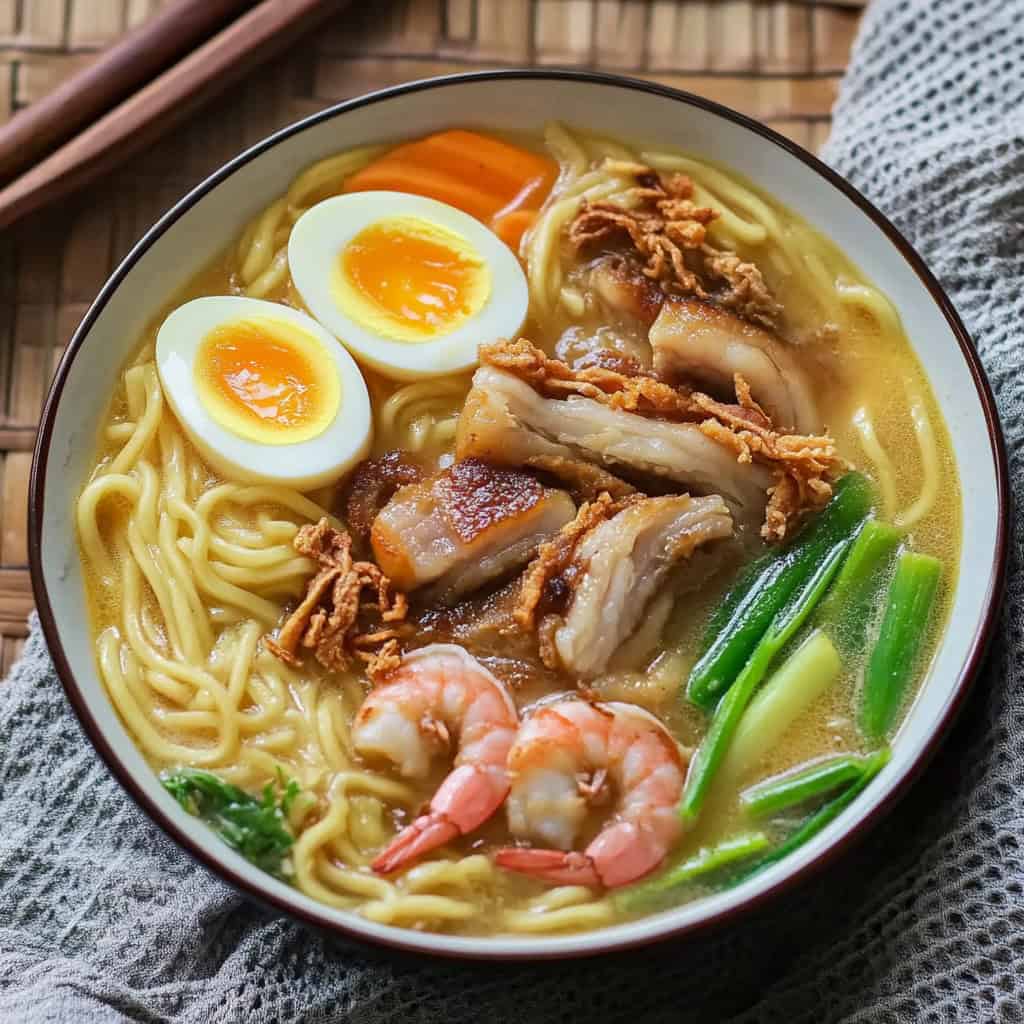
FAQ
Why is my broth not thickening?
Ensure your cornstarch slurry is mixed with cold water (not hot) and the broth is actively simmering when added. Cornstarch needs heat to activate its thickening properties.
Can I make this in advance for a party?
Yes, prepare the broth and toppings ahead, but cook noodles fresh before serving. Reheat the broth to boiling, then assemble bowls as guests arrive.
Is this dish spicy?
No, traditional Batangas lomi is not inherently spicy, but you can customize the heat level with siling labuyo (bird's eye chilies) served on the side.
How do I know when the noodles are perfectly cooked?
Lomi noodles should be chewy with some resistance when bitten, similar to al dente pasta but slightly softer. Test one noodle by biting through it.
Can I use regular eggs instead of beaten eggs?
The beaten eggs create the signature ribbon effect in the broth. Whole eggs won't distribute properly throughout the dish.
How thick should the broth be?
The broth should be substantial but still pourable—think of a consistency similar to heavy cream or a light gravy.
Is it normal for the soup to get thicker as it sits?
Yes, the cornstarch will continue to thicken the broth as it cools. If reheating, you may need to add a little more stock.
What makes Batangas lomi different from other lomi versions?
Batangas lomi is distinguished by its exceptionally thick broth, substantial egg noodles, and generous inclusion of crispy pork belly and seafood.
Related
Looking for other recipes like this? Try these:

Authentic Batangas Lomi Recipe
Equipment
- Large stockpot (kaldero) For cooking the broth and assembling the dish
- Wok or deep frying pan (kawali) For crisping the pork belly
- Strainer [Salaan] For draining the noodles
- Sharp knife (kutsilyo) For precise ingredient preparation
- Wooden spoon (sandok na kahoy) For stirring without scratching your pot
- Measuring cups and spoons (Panukat) For accurate measurements
- Small mixing bowl (mangkok) For preparing the cornstarch slurry
Ingredients
For the Broth Base:
- 500 g thick egg noodles lomi noodles
- 6 cups chicken stock sabaw ng manok
- 2 tablespoons cornstarch gawgaw
- 3 eggs beaten (itlog)
- 6 cloves garlic minced (bawang)
- 1 shallot finely chopped (sibuyas tagalog)
For the Toppings:
- 1½ cups pork belly cubed (liempo)
- 10 pieces squid balls halved (bola-bola ng pusit)
- 12 medium-sized prawns cleaned (hipon)
- ¼ head cabbage shredded (repolyo)
- 1 large carrot julienned (karot)
For Seasoning:
- Fish sauce patis to taste
- Fresh ground black pepper paminta to taste
- Cooking oil mantika
Optional Garnishes:
- Chopped green onions sibuyas dahon
- Fried garlic sinangag na bawang
- Calamansi
- Fresh red onions chopped (sibuyas)
- Bird's eye chilies siling labuyo
Instructions
- First, prepare your ingredients. Set out all your chopped vegetables, meats, and seasonings within easy reach of your stove.
- Start by cooking the lomi noodles in boiling water until they're chewy but not mushy, about 5-7 minutes. Drain them and rinse with cold water. Set aside.
- Heat oil in a deep pot over medium-high heat. Add your pork belly cubes and fry until they turn golden brown and crispy, about 5-7 minutes. Remove the pork and set aside, leaving the oil in the pot.
- In the same pot, cook garlic and shallots until they become fragrant and soft, about 1-2 minutes. Add the squid balls and cook them until lightly golden.
- Pour in your chicken stock and bring it to a boil. Once boiling, add the prawns and fried pork belly back to the pot. Let this simmer for 2 minutes.
- Mix cornstarch with a quarter cup of cold water until smooth. Pour this mixture slowly into the pot while stirring constantly. Keep stirring and let it simmer for 2 minutes until the broth thickens.
- Add your carrots and cabbage to the pot. Return everything to a boil, adding more hot water if needed to get the right thickness. The broth should be rich and thick but still fluid enough to be soupy.
- Turn off the heat. While stirring the soup in circles, slowly pour in your beaten eggs. Keep stirring until you see ribbons of egg throughout the broth.
- Season with fish sauce and black pepper to taste. Taste and adjust the seasoning if needed.
- Serve immediately while it's very hot. Put out small bowls of chopped green onions, fried garlic, calamansi, fresh red onions, and chilies so everyone can add their preferred toppings.
- Remember, lomi should be eaten right away while it's steaming hot - this is how you'll get the best flavor and texture.
Tips from Lola's Kitchen
- Use freshly made lomi noodles from your local market for the best texture
- Keep stirring the broth while adding cornstarch to prevent lumps
- Never overcook the vegetables to maintain their crunch
- Season gradually and taste as you go
- The broth should be thick enough to coat the back of a spoon
Nutrition
The Story Behind Batangas Lomi
In the heart of Batangas province, where culinary traditions run as deep as family roots, lomi stands as a testament to the fascinating intersection of Filipino and Chinese cuisines. This beloved noodle dish, with its characteristically thick egg noodles and rich, velvety broth, traces its origins to the Chinese dish "Lor Mee," brought to Philippine shores by immigrant merchants during the early 20th century.
What began as a simple noodle soup in the bustling ports of Batangas transformed into something uniquely Filipino through generations of local innovation. The adaptation reflects the ingenuity of Batangueño cooks, who enhanced the original recipe by incorporating local ingredients and adapting it to Filipino tastes. The addition of crispy pork belly, fresh seafood, and an array of vegetables created a heartier, more substantial dish that could satisfy the robust appetites of local workers and families.
The rise of dedicated lomi houses, locally known as "lomi haus" or "lomihan," marks a significant chapter in this dish's story. These establishments, often small family-run operations, began appearing in the 1970s, turning lomi from a simple home-cooked meal into a regional culinary icon. Today, these specialty restaurants dot the landscape of Batangas, each claiming to serve the most authentic version of this beloved comfort food.
Perhaps most intriguing is the cultural ritual that has developed around consuming lomi. Unlike other noodle dishes, tradition dictates that lomi must be eaten while piping hot, creating an experience that brings people together in a shared moment of culinary appreciation. This practice, unique to Batangas lomi, speaks to the dish's evolution from mere sustenance to a cultural phenomenon that builds community connections.
Modern interpretations of lomi continue to emerge, but the soul of the dish remains rooted in its humble origins. From street-side stalls to air-conditioned restaurants, lomi has maintained its status as a go-to comfort food, particularly beloved during rainy days and cool evenings. Its ability to adapt while maintaining its essential character makes it a perfect example of Filipino cuisine's dynamic nature.
The enduring popularity of Batangas lomi showcases how immigrant influences, local creativity, and community traditions can combine to create something truly special. In every steaming bowl, you'll find not just nourishment, but a story of cultural exchange, culinary innovation, and the warm hospitality that defines Filipino food culture.
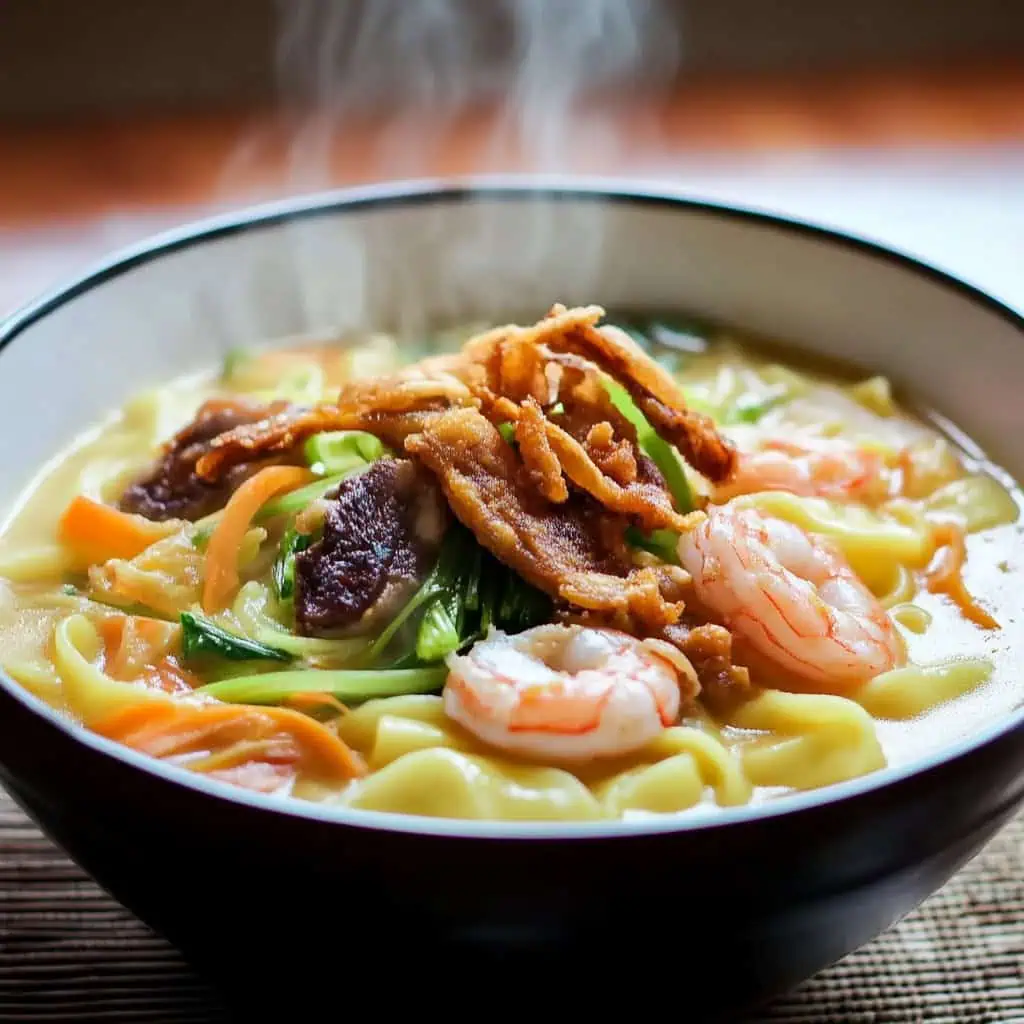





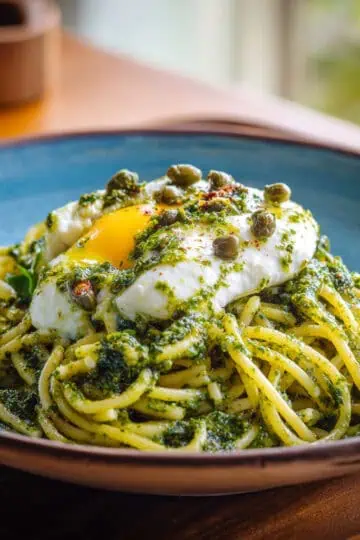
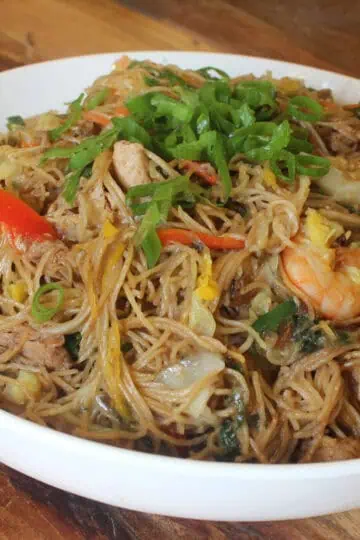
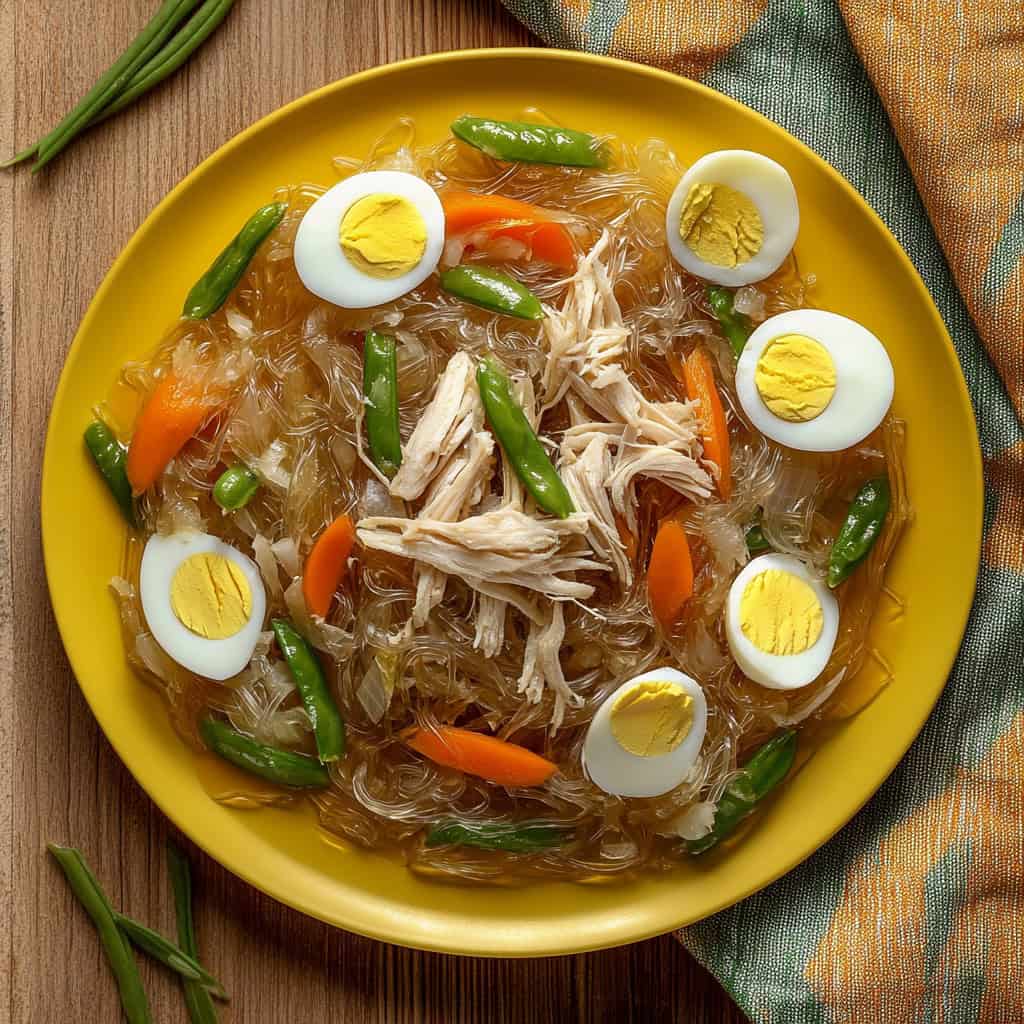
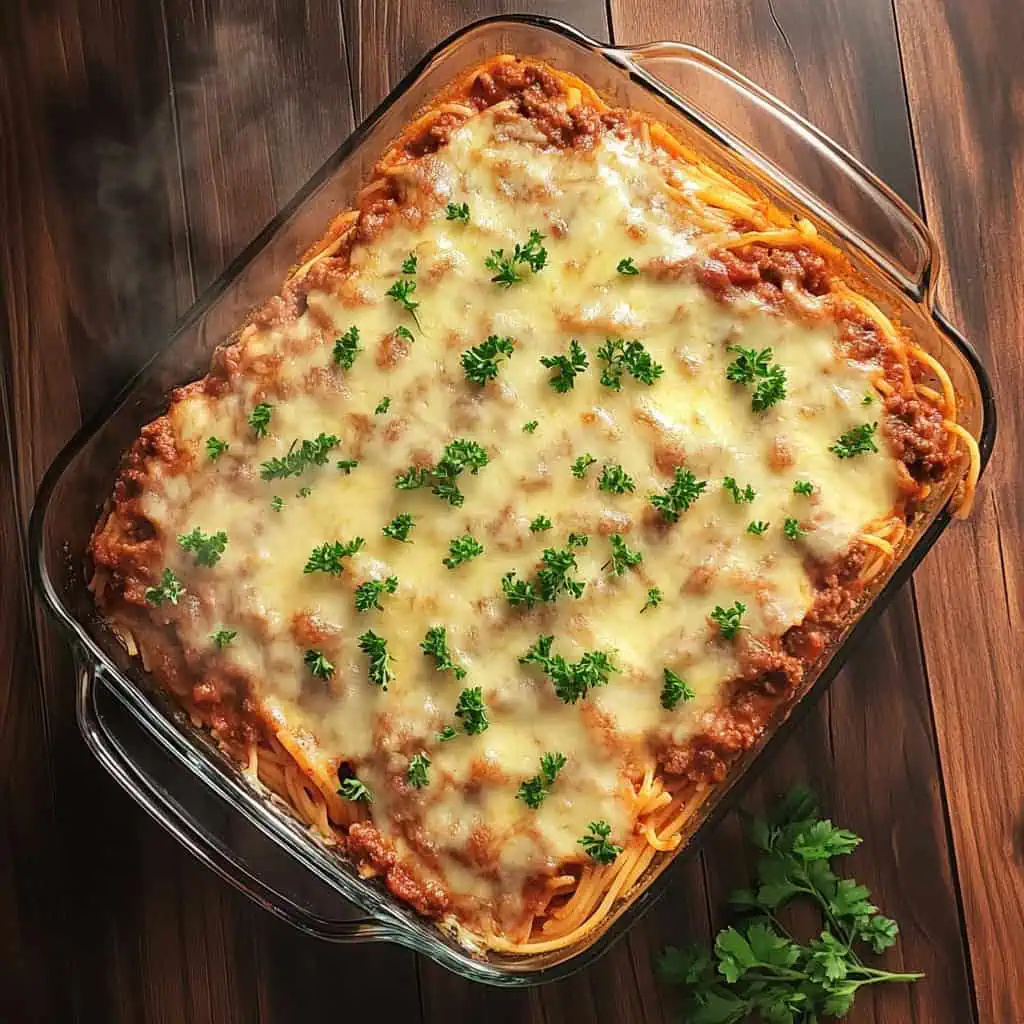
Comments
No Comments